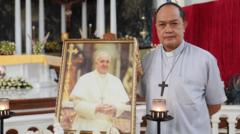In a solemn ceremony, the cardinals have sworn an oath under the watchful eye of tradition and sacred duty.
**Cardinals Unite in Oath-Binding Ritual at Papal Conclave**

**Cardinals Unite in Oath-Binding Ritual at Papal Conclave**
Cardinals commence secret conclave in Sistine Chapel as they prepare to elect the next pope.
In the heart of Vatican City, the Sistine Chapel reverberates with the voices of 133 cardinals as they take a solemn oath, guided by the regulations set forth by Pope John Paul II in 1996. This moment marks the official commencement of the papal conclave, where the future leader of the Catholic Church will soon be chosen.
As the most senior cardinal leads the rite in Latin, the assembly of cardinals promises to adhere strictly to the conclave's rules, pledging their commitment to the legacy and mission of Saint Peter, the Church’s inaugural pope. Each cardinal articulates a vow: to tirelessly support the spiritual and temporal rights afforded to the Holy See.
A significant part of their commitment encompasses a vow for discretion; the cardinal electors guarantee that all discussions and votes will remain confidential, unless otherwise revealed by the newly appointed pope. The protocol includes the destruction of any notes—both ballots and related documents burned up to twice daily, ensuring the integrity of the process.
Despite the veil of secrecy, insights into the conclave’s procedural dynamics occasionally leak through various channels, often posing intriguing narratives crafted by Vatican journalists. In some instances, anonymous cardinal memoirs have emerged, shedding light on pivotal moments from prior elections, such as the selection of Pope Benedict XVI in 2005.
With the oaths completed, the final cardinal’s pledge prompts Diego Ravelli, the master of papal liturgical ceremonies, to announce “extra omnes,” or “everybody out.” This marks the beginning of a sacred election process, wherein only select individuals, including Ravelli, may remain—a practice that safeguards the voting proceedings.
As the world awaits the next chapter in papal history, the cardinals remain resolute, honoring the traditions that shape their revered institution.
As the most senior cardinal leads the rite in Latin, the assembly of cardinals promises to adhere strictly to the conclave's rules, pledging their commitment to the legacy and mission of Saint Peter, the Church’s inaugural pope. Each cardinal articulates a vow: to tirelessly support the spiritual and temporal rights afforded to the Holy See.
A significant part of their commitment encompasses a vow for discretion; the cardinal electors guarantee that all discussions and votes will remain confidential, unless otherwise revealed by the newly appointed pope. The protocol includes the destruction of any notes—both ballots and related documents burned up to twice daily, ensuring the integrity of the process.
Despite the veil of secrecy, insights into the conclave’s procedural dynamics occasionally leak through various channels, often posing intriguing narratives crafted by Vatican journalists. In some instances, anonymous cardinal memoirs have emerged, shedding light on pivotal moments from prior elections, such as the selection of Pope Benedict XVI in 2005.
With the oaths completed, the final cardinal’s pledge prompts Diego Ravelli, the master of papal liturgical ceremonies, to announce “extra omnes,” or “everybody out.” This marks the beginning of a sacred election process, wherein only select individuals, including Ravelli, may remain—a practice that safeguards the voting proceedings.
As the world awaits the next chapter in papal history, the cardinals remain resolute, honoring the traditions that shape their revered institution.





















